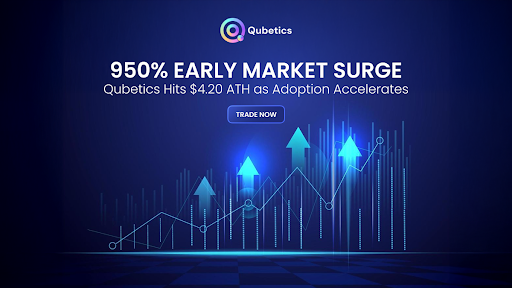Ethereum Price Prediction 2030: Can ETH Hold Its Ground as Qubetics Registers a 950% Rally?
Ethereum eyes $30K by 2030, but Qubetics’ 950% rally shakes the market. Can ETH retain dominance as infrastructure-first chains redefine crypto’s next growth era?

Ethereum continues to dominate smart contract infrastructure, processing billions in on-chain value and powering thousands of decentralized applications. But as 2030 approaches, the competition is growing louder. New projects like Qubetics are not only launching with developer-first tools but have also stunned the market with explosive returns.
Qubetics surged 950% within an hour of listing on MEXC and LBank, securing a position among the top 10 cryptos on CoinMarketCap. Meanwhile, Ethereum faces critical questions: Can it maintain dominance? Will upgrades keep pace with scaling demands? Or is its growth curve flattening?
Ethereum’s Layer-1 Maturity and Real-World Integration
Ethereum remains the most widely adopted smart contract platform. It transitioned to Proof-of-Stake in 2022 through the Merge, cutting its energy use by over 99%. This move positioned ETH as the leading eco-efficient Layer-1 blockchain. But Ethereum’s real power lies in its Layer-2 ecosystem. Rollups such as Arbitrum and Optimism now manage a significant portion of transaction volume. Protocols like Dencun and the upcoming Pectra upgrade further reduce gas fees and increase throughput.
Ethereum also benefits from real-world integrations. Stablecoins like USDC and DAI operate largely on Ethereum rails. Tokenized treasury bonds, NFTs, and institutional DeFi are all being built using the ERC-20 and ERC-721 standards. As a result, Ethereum hosts over $50 billion in Total Value Locked and supports staking across multiple validator networks.
ETH Price Performance in 2025: A Volatile Base Forming
As of mid-2025, Ethereum is trading near $2,550. The asset has declined from highs of $3,200 earlier this year due to macro pressures and mixed ETF approval timelines. However, on-chain data reveals strong fundamentals. Over 30% of ETH supply is locked in staking contracts, creating downward pressure on available supply.
Technical indicators suggest Ethereum is forming a long-term accumulation base. The 200-day EMA has flattened, and RSI remains near 50. Analysts expect a breakout if ETH closes consistently above $2,950, targeting the $3,800 resistance next.
Ethereum Price Prediction 2030: Strategic Models in Focus
Forecasts for Ethereum’s 2030 value vary widely. Binance user consensus estimates ETH at $3,200 by 2030, assuming modest annual growth. More bullish forecasts from TradingView and CoinPedia place ETH between $12,600 and $15,500, driven by staking rewards, protocol fees, and continued DeFi dominance.
VanEck’s institutional model places ETH at $11,800 by 2030, based on discounted cash flow from ETH network fees. More aggressive scenarios from Bitget and Flitpay suggest a range of $20,000 to $30,000, assuming ETH captures 50–70% of future decentralized transaction volume.
If Ethereum sustains its Layer-2 scaling and continues onboarding institutional capital, analysts believe a $15,000–$22,000 price by 2030 is plausible. This depends on the successful implementation of rollup-centric infrastructure, reduced MEV (miner extractable value), and further Layer-1 optimization.
Regulatory and Technical Headwinds
Ethereum’s roadmap is ambitious but not without friction. U.S. regulatory ambiguity has delayed spot ETF approvals. Additionally, Ethereum faces competition from modular chains, AI-based networks, and Layer-1s offering better composability.
Security is another challenge. As Ethereum scales through rollups and sharding, contract complexity increases. Without rigorous auditing and formal verification, the risk of exploits and rug pulls rises. Still, Ethereum’s active developer base and extensive documentation give it a strong foundation to respond swiftly.
Qubetics: Infrastructure-First Chain With Immediate Impact
Qubetics entered the market with a unique positioning, offering a fully non-custodial multi-chain wallet as its first core application. This tool enables users to store, swap, and transfer assets across multiple blockchains without relying on third-party custodians.
The wallet’s architecture supports hardware-level encryption, decentralized key storage, and AI-assisted address book functions. For global users, especially in emerging markets, this app bridges the accessibility gap and enhances security without the need for traditional banking infrastructure.
Developers have taken note. Qubetics IDE simplifies smart contract deployment with visual workflows, reducing build time by 60% compared to conventional development environments. Combined with QubeQode, the ecosystem is attracting early builders looking to launch on an infrastructure-backed chain.
Presale and ROI: From $0.01 to $4.20
Qubetics officially listed on MEXC and LBank on June 30 at $0.40. It also went live on SWFT Bridge, opening liquidity across ecosystems. Within 60 minutes, Qubetics exploded to an all-time high of $4.20, marking a 950% gain.
This surge followed a meticulously structured presale that spanned 37 stages, starting at $0.01 and ending at $0.3370. Total fundraising exceeded expectations, and the post-launch performance validated long-term demand.
Trading volume on MEXC surpassed $700,000 within the first 24 hours. Support has since formed around the $2 level, with visible buy pressure accumulating on both centralized and decentralized exchanges. Analysts predict a target range of $5 to $10 in the next cycle for this best crypto ico to invest in 2025.
But this listing was more than a liquidity event. It triggered mainstream onboarding opportunities, attracted institutional market makers, expanded developer interest, and accelerated token velocity. It also positioned Qubetics for seamless integration into broader crypto infrastructure during Q3 and Q4 of 2025. Qubetics is now among the top 10 trending cryptocurrencies on CoinMarketCap, a significant signal of community traction and visibility.
Final Thoughts:
Ethereum remains the dominant smart contract platform. Its base-layer improvements, Layer-2 scalability, and validator-backed staking give it a unique combination of decentralization and performance. ETH has shown resilience, even during broader market contractions.
However, the speed at which projects like Qubetics are gaining traction highlights the shifting dynamic in Layer-1 competition. If Ethereum continues to lead in innovation while staying responsive to emerging threats, it may not only hold ground but break into higher valuation zones.
If it stalls, though, the market may continue rewarding newer entrants that deliver speed, accessibility, and usability at launch. The road to 2030 will not be about legacy alone, it will depend on execution.
For More Information:
Qubetics: https://qubetics.com
Telegram: https://t.me/qubetics
Twitter: https://x.com/qubetics
Summary:
Ethereum’s 2030 price projection ranges from $3,200 to $30,000 depending on adoption, Layer-2 scaling, and institutional growth. While Ethereum continues to lead the smart contract space, newer contenders like Qubetics have shocked the market with a 950% rally post-launch, backed by a multi-chain wallet, developer tools, and strong exchange listings. The question heading into 2030 is whether Ethereum’s roadmap can outpace rising challengers or if market share will shift toward faster, infrastructure-first ecosystems.



